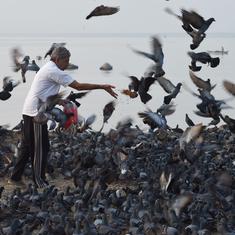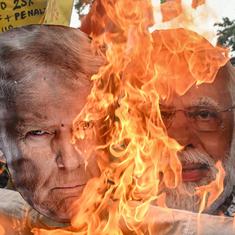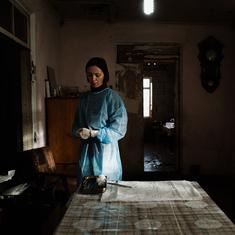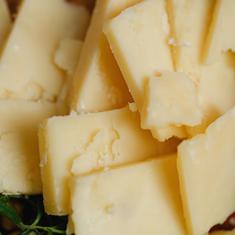Spoilers ahead for ‘Game of Thrones’ season 8 episode 6.
In her eight-season run on Game of Thrones, Daenerys Targaryen (Emilia Clarke) told everyone who would listen that the Iron Throne was hers by right – and winning it back for her family was her one goal.
That victory came in heartbreaking fashion for the Mother of Dragons in the series finale of the HBO behemoth. Amid the debris of the Westerosi capital she had conquered with fire and blood in the previous episode, Daenerys rose as the queen of the ashes but died within striking distance of the seat of power she had fantasised about for years.
Life comes at you fast. pic.twitter.com/okGVdtgQu7
— Saeed Jones (@theferocity) May 6, 2019
It was a tragic turn for a character who, over seven seasons, had been depicted as the rightful claimant to the Iron Throne, one who combined ambition with compassion and the quest for power with a higher purpose of bringing peace and justice to her kingdom. But as the final season began on April 14, Daenerys’s fortunes had turned. By episode five, her transition to Mad Queen – a ruthless tyrant with delusions of grandeur and a self-serving definition of justice – was complete.
How did the woman who sought to “break the wheel” end up breaking bad?
For many viewers, the reversal of fortunes seemed to have come upon Daenerys without warning, a sudden pivot in the eighth season. As David Benioff and DB Weiss tried to wrap up the sprawling universe of Game of Thrones over a six-episode final season through haphazard developments and careless plotting, the Mother of Dragons became the biggest casualty.
After spending seven seasons laboriously tracing Daenerys’s rise from a meek girl to a formidable contender for the Iron Throne, the legacy of “Daenerys Stormborn of the House Targaryen, First of Her Name, the Unburnt, Queen of the Andals and the First Men, Khaleesi of the Great Grass Sea, Breaker of Chains, and Mother of Dragons” was collapsed into the diminutive title of “Mad Queen”.

Enter the dragon
When Daenerys was introduced in the show’s first episode, she was a pawn in her cruel bother’s bid for the Iron Throne. Her rebirth came in the first season’s finale, when she stepped into the funeral pyre of her deceased husband Khal Drogo (Jason Momoa). From the ashes rose the Mother of Dragons, three hatchlings on her shoulders. The memorable moment was a powerful combination of magic and myth-making, setting up Daenerys as the one who could single-handedly resurrect the Targaryen dynasty.
Now determined to conquer Westeros, Daenerys travelled to Qarth, Astapor, Yunkai and Mereen, building up skills and resources, winning loyal aides and stitching together a diverse and formidable army of the Unsullied and the Dothraki. This rapid transition from subservience to supremacy may not have always been convincing, but it resonated with viewers, making her character a global fan favourite and helping redeem a show that had had a patchy track record in female representation.
Despite routine reminders that madness ran in Daenery’s genes – her father, Aerys II Targaryen, was the original Mad King – the show spent considerable time steering the apple away from the tree. Where Westeros’s other Mad Queen contender, Cersei, dived headfirst into insanity, growing increasingly ruthless as the series progressed, Daenerys surrounded herself with advisers who would help curb her reckless impulses, used violence sparingly and tried to create a quasi-democratic set up in the lands she ruled.
By the time she finally reached Westeros in season seven, Daenerys seemed unbeatable.
The Mad Queens
Even when Daenerys’s star was rising, there were signs that her ambition could become her hubris – but these were to be found by reading between the lines.
Her belief in her birthright to the throne and her proclamations that she was the chosen ruler had the makings of despotism. Her most celebrated achievement in the series – the liberation of the slave cities of Asatpor, Yunkai and Mereen – was premised on a sense of entitlement and the imposition of her moral values on a foreign land.
But for much of Game of Thrones, Daenerys continued to be cloaked in messianic glory, getting some of the show’s most spectacular season finale moments. A memorable example is Mhysa, the last episode of season three, which ended with Daenerys being lifted up to the skies and hailed as a mother by the thousands of slaves she had set free in Yunkai.
Daenerys’s experience in Mereen raised questions about her fitness to rule – a civil war broke out under her watch, with former slave owners refusing to except her abolition of slavery, leaving the Targaryen heir at a loss on how to douse the flames. George RR Martin’s A Song of Ice and Fire novels, on which the series is based, made clear that her reign over Mereen had done more harm than good, but the collateral damage was treated as a side note in the series.
The violent culmination of Daenerys’s missteps was the massacre by the pro-slavery militant outfit Sons of the Harpy in the fighting pits in season five episode The Dance of Dragons. As the Sons of the Harpy killed hundreds in the fighting pit, Daenerys discovered her ability to ride dragons, and soared away from danger on the back of Drogon, turning the debacle into a candidate for a “Daenerys’s best dragon moments” showreel.
Further cementing the idea of Daenerys-as-saviour was the stamp of approval by Varys (Conleth Hill), the self-proclaimed protector of the realm, who pitched her to Tyrion (Peter Dinklage) as the ideal candidate for the Iron Throne and ferried him across continents to join her cause. It seemed unfathomable that the wily Master of Whisperers misread Daenerys till the very end. Consequently, when Varys abruptly changed his assessment by season eight, foreshadowing her descent into madness, it seemed less a natural culmination of her plot and more a sudden shift in the series’s stance towards the Mother of Dragons.
Oh no, Jon Snow
Up until the end of season seven, Daenerys was still on the right side of Game of Thrones history. She acquired an ally and eventual lover in Jon Snow (Kit Harington) after her arrival in Westeros and even though she forced him to swear fealty to her, another sign of her authoritarian streak, she showed the ability to set aside her territorial ambitions for the greater good when she agreed to join forces with him in the battle against the Night King’s army.
One turning point was the killing of Randyll and Dickon Tarly (James Sebastian Faulkner and Billy Bones) in season seven after they refused to swear fealty to her. The action invited the discomfiture of her advisors, Varys (Conleth Hill) and Tyion Lannister (Peter Dinklage), and found her no favours with Samwell Tarly (Josh Bradley), who, as one of the few unequivocally “good” characters in the show, doubles up as the moral compass of Westeros.
But her decline only came into clear focus when another heir to the throne had entered the scene. At the end of season seven, it was revealed that Jon Snow was not Ned Stark’s bastard son but was Aegon Targaryen, the secret child of Rhaegar Targaryen and Lyanna Stark, and Daenery’s nephew.
As season eight began, the Mother of Dragons would now be reduced to the mother of tantrums, as the show’s writers abandoned her for the new Targaryen in the house. Daenerys sacrificed one dragon and a bulk of her armies to Jon Snow’s cause, and walked away with her sanity compromised. The hunky former bastard has had a poor track record with women – his first love, Rose Leslie’s fierce Wildling Ygritte, was betrayed by him and killed by his Night’s Watch brothers. The Dany-Jon romance has come into criticism for its poor plotting, but their lack of chemistry seems to have been a lesser crime than her gradual weakening after coming into contact with him.
Daenerys spent much of her final episodes on the sidelines, glowering at the Northerners upon arrival at Winterfell for refusing to welcome her and growing increasingly insecure after learning of Jon Snow’s true identity. The Stark sisters were resolutely against her and angered by Jon’s decision to give up the North’s independence to her. By episode four, the show articulated its stance on her through Varys, who was now openly proclaiming that the show’s loyalties had shifted to team Jon
And things came full circle for the Targaryen dynasty when, in The Bells, Daenerys unleashed havoc on King’s Landing, her dragon fire igniting her father’s hidden wildlfire reserves in the capital, creating double the carnage and continuing her rampage long after the capital had surrendered.

Exit the dragon
A more linear and consistent picture of Daenerys’s decline can be traced by seeing her fate as inextricably linked to her dragons. Dragons were the source of Daenerys’s strength, not just because of the fire power but also her supernatural connection with her three “children”.
In season one, when Daenerys had a hard time fitting in with Dothraki and her relationship with Khal Drogo comprised little more than brutish sex, it was the sight of her unhatched dragon eggs that gave her strength. Similarly in Martin’s books, it’s a dream about a dragon that set the lost and lonely Daenerys on a path towards assertiveness. As Daenerys’s dragons grew, so did her powers.
Following the death of her first dragon during the battle with the Night King’s zombie army of White Walkers in the penultimate episode of season seven, Daenerys was in discernibly poorer form. In episode four of the final season, Daenerys lost her second dragon, Rhaegal, and was also at her weakest position yet. She had lost Jorah and half her army, was about to lose Missandei, and her advisor Varys was contemplating treason by dumping her for Jon Snow.
Daenery’s demise, then, can also been seen as the end of magic in Game of Thrones. Martin’s novels have used fantasy sparingly, finding more potency in forces of good and evil in humans. The Night King was one of the last vestiges of the supernatural in Game of Thrones. By defeating him early on in the series, Game of Thrones made clear that its focus would continue to be on messy real-world politics. The combination of power-lust and magic that Daenerys and her dragons represented had no place in the all-too-real world of Westerosi politics.











